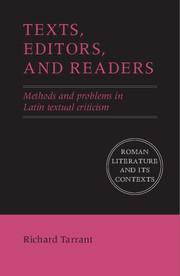Book contents
- Frontmatter
- Dedication
- Contents
- Preface
- Introduction
- 1 Textual criticism in a post-heroic age
- 2 The rhetoric of textual criticism/textual criticism as rhetoric
- 3 Establishing the text 1: recension
- 4 Establishing the text 2: conjecture
- 5 Establishing the text 3: interpolation, collaboration, and intertextuality
- 6 Textual criticism and literary criticism: the case of Propertius
- 7 Presenting the text: the critical edition and its discontents
- 8 The future: problems and prospects
- Appendix Reading a critical apparatus
- Bibliography
- General index
- Index of passages discussed
- Index of scholars
Appendix - Reading a critical apparatus
Published online by Cambridge University Press: 05 March 2016
- Frontmatter
- Dedication
- Contents
- Preface
- Introduction
- 1 Textual criticism in a post-heroic age
- 2 The rhetoric of textual criticism/textual criticism as rhetoric
- 3 Establishing the text 1: recension
- 4 Establishing the text 2: conjecture
- 5 Establishing the text 3: interpolation, collaboration, and intertextuality
- 6 Textual criticism and literary criticism: the case of Propertius
- 7 Presenting the text: the critical edition and its discontents
- 8 The future: problems and prospects
- Appendix Reading a critical apparatus
- Bibliography
- General index
- Index of passages discussed
- Index of scholars
Summary
The following pages are meant for readers of critical editions who wish to make use of the information in an apparatus and who would welcome guidance in interpreting the form in which that information is presented. As in other areas of textual criticism, there are no strict rules about the form and content of an apparatus; there is also considerable diversity among editors and series of editions. I have promoted what I consider to be best practices and have tried to offer some rationale for my preferences.
General
Apparatuses can take many forms, serving a variety of purposes and audiences. In all cases, though, the principles on which an apparatus is based should be clearly explained and consistently applied. The preface to an edition will therefore usually contain a section setting out the types of evidence that the apparatus does and does not attempt to record and explaining any special conventions or vocabulary that the editor has employed. An apparatus should strive above all to be clear and easily legible; economy is often a means to that end, but when brevity requires a user to work harder, it defeats its purpose.
Latin versus English
The Latin preface may soon be a thing of the past, but even the editors who have opted to write their prefaces in English have retained Latin for the apparatus. Since Latin is the language of all existing apparatuses and is likely to remain the primary language of those of the future, I have assumed it for the purpose of this introduction.
Manuscripts
Manuscripts are generally referred to by sigla, the most common form of which is a letter of the alphabet. That convention became standard in the course of the nineteenth century, replacing a fuller style in which manuscripts were designated by the Latin form of their location or owner, for example, Vaticanus primus or codex Vossii. Many single-letter sigla allude to those Latin designations (M is often used for Mediceus or Monacensis, P for Palatinus or Parisinus, and so on), but, depending on the number of manuscripts involved, it may not be possible to make all the sigla function in that way.
- Type
- Chapter
- Information
- Texts, Editors, and ReadersMethods and Problems in Latin Textual Criticism, pp. 157 - 169Publisher: Cambridge University PressPrint publication year: 2016



